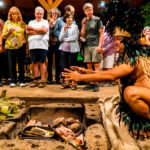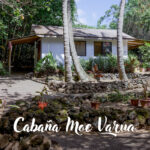The Cult of the Bird-Man
Located on the southwestern edge of the immense crater of Rano Kau in front of three small islets where migratory marine birds used to nest in the spring, Orongo has to be one of the most spectacular places on Rapa Nui. The ceremonial village of Orongo, built of basalt slabs, is associated with the cult of Tangata Manu (Bird-Man) which was celebrated roughly between 1680 and 1866, although the first houses seem to have been constructed for other purposes around the year 1200 A.D. Interestingly, before getting to the village itself, one finds the remains of a small Ahu (ceremonial platform) which some scholars relate with the solstices.
For the Tangata Manu ceremonies, 53 oval houses, aligned with the border of the crater, were built to house the participants during the festivities. In the interior of these constructions, there were vertical slabs, attached to the walls, which were painted with designs that were characteristic of the Bird-Man ceremonies. Here was also found, inside one of the houses in the central area called Taura Renga, a basalt statue that was 2 and a half meters (8 feet) high which was given the name Hoa Haka Nana Ia. This Moai (statue), weighing 4 tons, was painted with red earth over a white base and, with the ancient history of the Bird-Man carved on its back, represents the political and social changes that occurred in the local culture at that time. In 1868 it was taken by an English archaeological expedition and is today prominently exhibited at the British Museum in London.

At the far end of the village, there are six individual chambers carved into the rock and completely covered with petroglyphs. This area, called Mata Ngarau, was the focus of the ceremony which was repeated every spring for nearly 200 years, until the arrival of Christian missionaries. Throughout the area of Orongo, one can still appreciate rocks that are decorated with 1,875 petroglyphs of the god Make-Make, of Komari (female vulva) and of Tangata Manu, beings with a human body and the head of a bird, some of them raising a sacred egg in their hand.


















